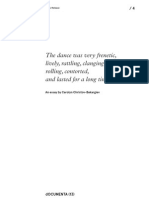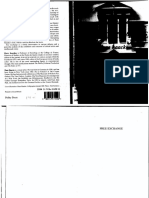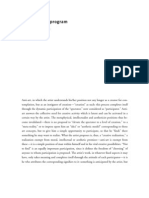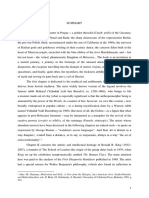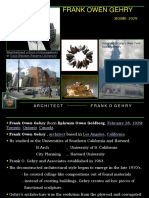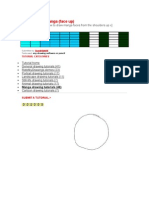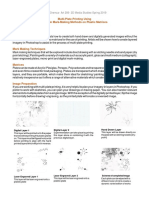Harald Szeemann
Harald Szeemann
Uploaded by
Sílvia PintoCopyright:
Available Formats
Harald Szeemann
Harald Szeemann
Uploaded by
Sílvia PintoCopyright
Available Formats
Share this document
Did you find this document useful?
Is this content inappropriate?
Copyright:
Available Formats
Harald Szeemann
Harald Szeemann
Uploaded by
Sílvia PintoCopyright:
Available Formats
Live in Your Head : When Attitudes Become Form : Works, Concepts, Processes, Situations, Information / wenn Attitden Form
werden : Werke, Konzepte, Vorgnge, Situationen, Information / quand les attitudes deviennent forme : oeuvres, concepts, processus, situations, information / quando attitudini diventano forma : opere, concetti, processi, situazioni, informazione] Harald Szeemann, Scott Burton, Grgoire Mller, Tommaso Trini, Carl Andre, Giovanni Anselmo, Richard Artschwager, Robert Barry, Joseph Beuys, Alighiero Boetti, Michael Buthe, Hanne Darboven, Jan Dibbets, Eva Hesse, Edward Kienholz, Yves Klein, Joseph Kosuth, Jannis Kounellis, Sol LeWitt, Richard Long, Walter De Maria, Mario Merz, Robert Morris, Bruce Nauman, Claes Oldenburg, Panamarenko, Markus Raetz, Reiner Ruthenbeck, Robert Ryman, Fred Sandback, Richard Serra, Robert Smithson, Keith Sonnier, Richard Tuttle, Lawrence Weiner 2006 facsimile edition of the exhibition catalogue published for the show held March 22 - April 27, 1969. Exhibition traveled to Institute of Contemporary Art, London, with variant catalogue. "An exhibition sponsored by Philip Morris Europe." Extensive and primary exhibition dedicated to the amalgam of Pop, Minimal and Conceptual Art. Texts by Harald Szeemann, Scott Burton, Grgoire Mller and Tommaso Trini. Artists include Carl Andre, Giovanni Anselmo, Richard Artschwager, Thomas Bang, Jared Bark, Robert Barry, Joseph Beuys, Mel Bochner, Marinus Boezem, Bill Bollinger, Michael Buthe, Pier Paolo Calzolari, Paul Cotton, Alighiero Boetti, Hanne Darboven, Jan Dibbets, Ger Van Elk, Rafael Ferrer, Barry Flanagan, Hans Haacke, Michael Heizer, Douglas Huebler, Paolo Icaro, Alain Jacquet, Neil Jenney, Jo Ann Kaplan, Eva Hesse, Edward Kienholz, Yves Klein, Joseph Kosuth, Jannis Kounellis, Gary B. Kuehn, Sol LeWitt, Richard Long, Roelof Louw, Bruce McLean, Walter De Maria, David Medalla, Mario Merz, Robert Morris, Bruce Nauman, Claes Oldenburg, Dennis Oppenheim, Paul Pechter, Panamarenko, Michelangelo Pisteletto, Emilio Prini, Markus Raetz, Allen Ruppersberg, Reiner Ruthenbeck, Robert Ryman, Alan Saret, Sarkis, Jean-Frdric Schnyder, Fred Sandback, Richard Serra, Robert Smithson, Keith Sonnier, Richard Tuttle, Frank Viner, Erhard Walther, Lawrence Weiner, William Wegman, William Wiley and Gilberto Zorio. Includes a biography, bibliography, illustrations and portrait for each artist. Texts in English, French, German and Italian. Bern, Switzerland : Kunsthalle Bern, 1969 / 2006 ; exhibition catalogue ; non-standard binding ; offset-printed ; black-and-white ; 31.5 x 24 cm ; [170] pp. ; edition size 1000 ; unsigned and unnumbered
HARALD SZEEMANN, who died in February at the age of seventy-one, was the most influential curator of his generation--and, arguably, the most influential of all time, since he practically defined the curator's role as we understand it today. For decades, he worked out of a studio he called "The Factory" in the small Swiss village of Tegna, conceiving exhibitions that were international in scope and consistently dodging the
categories of traditional museum practice, often daring to place historical and contemporary artworks beside anthropological artifacts, sacred objects, technical devices, and occult instruments. Szeemann sought, he said, to create shows that were "poems in space." And in the wake of his move away from quasi-scientific museological attempts to classify and order cultural material, the figure of the curator would no longer be seen as a blend of bureaucrat and cultural impresario. Instead, he emerged as a kind of artist himself, or as some would say--with no small degree of skepticism toward Szeemann's genuine belief that art exhibitions were spiritual undertakings with the power to conjure alternative ways of organizing society--a metaartist, utopian thinker, or even shaman. Szeemann himself preferred the down-to-earth Ausstellungsmacher (exhibition maker) as his job title. But this modest term hardly conveys a real sense of his curatorial endeavors, whose "controlled chaos" (Szeemann's phrase) might productively be traced back to his brief career in theater during the 1950s, which included a renowned transvestite act and an homage to Dadaist Hugo Ball before ending with his egomaniacal one-man production of Urfaust in 1956 (yes, Szeemann played all the roles himself). "It gives you the same rhythm as in theater, only you don't have to be on stage constantly," he said in these pages regarding his decision in 1957 to enter the art world and direct exhibitions. Four years later, at the age of twenty-eight, he became director of the Kunsthalle Bern. It was a rather provincial institution at the time, but the bare-bones venue--precisely because it lacked any permanent collection--dictated that Szeemann take up a kind of improvisational, laboratory approach and working style that he would maintain throughout his life. At an unbelievable pace--an exhibition opened every month--Szeemann introduced a baffled local audience to the newest generation of American and European artists, many of whom received their earliest opportunities from the young director. Christo and Jeanne-Claude's first major project, for example, was wrapping the kunsthalle in 1968; and the venue also offered Andy Warhol one of his first shows in a European institution. HARALD SZEEMANN, who died in February at the age of seventy-one, was the most influential curator of his generation--and, arguably, the most influential of all time, since he practically defined the curator's role as we understand it today. For decades, he worked out of a studio he called "The Factory" in the small Swiss village of Tegna, conceiving exhibitions that were international in scope and consistently dodging the categories of traditional museum practice, often daring to place historical and contemporary artworks beside anthropological artifacts, sacred objects, technical devices, and occult instruments. Szeemann sought, he said, to create shows that were "poems in space." And in the wake of his move away from quasi-scientific museological attempts to classify and order cultural material, the figure of the curator would no longer be seen as a blend of bureaucrat and cultural impresario. Instead, he emerged as a kind of artist himself, or as some would say--with no small degree of skepticism toward Szeemann's genuine belief that art exhibitions were spiritual undertakings with the power to conjure alternative ways of organizing society--a metaartist, utopian thinker, or even shaman. Szeemann himself preferred the down-to-earth Ausstellungsmacher (exhibition maker) as his job title. But this modest term hardly conveys a real sense of his curatorial endeavors, whose "controlled chaos" (Szeemann's phrase) might productively be traced back to his brief career in theater during the 1950s, which included a renowned
transvestite act and an homage to Dadaist Hugo Ball before ending with his egomaniacal one-man production of Urfaust in 1956 (yes, Szeemann played all the roles himself). "It gives you the same rhythm as in theater, only you don't have to be on stage constantly," he said in these pages regarding his decision in 1957 to enter the art world and direct exhibitions. Four years later, at the age of twenty-eight, he became director of the Kunsthalle Bern. It was a rather provincial institution at the time, but the bare-bones venue--precisely because it lacked any permanent collection--dictated that Szeemann take up a kind of improvisational, laboratory approach and working style that he would maintain throughout his life. At an unbelievable pace--an exhibition opened every month--Szeemann introduced a baffled local audience to the newest generation of American and European artists, many of whom received their earliest opportunities from the young director. Christo and Jeanne-Claude's first major project, for example, was wrapping the kunsthalle in 1968; and the venue also offered Andy Warhol one of his first shows in a European institution. "The Bachelor Machines" was among Szeemann's most original projects, based on what he described as "a belief in eternal energy flow as a way to avoid death, as an erotics of life." Terrifying yet fascinating apparatuses have been conceived by, among others, Franz Kafka, Marcel Duchamp, Raymond Roussel, and Alfred Jarry, and in their "splendid ambiguity," he wrote in the show's catalogue, these machines stand for "the omnipotence of eroticism and its negation, for death and immortality, for torture and Disneyland, for fall and resurrection." That exhibition, along with such others as "Monte Verita," named for an early-twentieth-century utopian commune of artists and intellectuals (1978), or "Gesamtkunstwerk" (1983), named after the Wagnerian vision, allowed the curator's own passions and obsessions to fully materialize, and through them, Szeemann's unique signature became most legible. These shows perhaps best fit Szeemann's presentation of himself as a lonesome cowboy--"old school," he said to me in an interview for Artforum in 2001--who preferred doing everything solo instead of surrounding himself with a team of advisors. A notable exception was his 1972 Documenta 5, generally seen as the most pioneering of the Kassel extravaganzas--emulating the "controlled chaos" of his Bern days, Szeemann famously refashioned the show from a "100 Day Museum" to a "100 Day Event"--and likely the first example of a large-scale exhibition with separate sections organized by different curators and devoted to individual themes, including realism, propaganda, art by the mentally disturbed, and science fiction. The most controversial category was also the one that most clearly belonged to Szeemann. Originally labeled "Mysticism and Shamanism" in an apparent nod to Joseph Beuys, who was at Documenta in a makeshift office answering questions about art, Szeemann ultimately settled on the title "Individual Mythologies," a phrase he coined with respect to French sculptor and alchemist Etienne Martin's hermetic cosmos--which seemed to him to be built upon an intricate yet impenetrable system of signs, a kind of myth unknowable to anyone but the artist himself. So, Szeemann seemed to ask, how can a deeply "egocentric" universe ever be communicated in a language shared by many? When criticized for having produced a confusing oxymoron rather than a helpful artistic category, Szeemann referenced Viennese actionists, Vito Acconci, Christian Boltanski, Mario Merz, and Paul Thek, insisting that, in the end, all truly interesting artists are the originators of individual mythologies. Yet in Szeemann's view there were also fascinating creators of individual mythologies outside of the art world. One of the
most unusual shows he ever staged happened soon after Documenta 5 and took place in his modest apartment in Zurich: "Grandfather-a pioneer like us" (1974). Described as "a torture chamber in the service of beauty," it presented the personal belongings--first and foremost the hairdressing equipment--of Szeemann's beloved grandpa, a Hungarianborn hairdresser and adventurer who died in 1971 at the age of ninety-eight. In Szeemann's opinion this show remained one of his more important achievements: an arresting and unique glimpse of the evasive, heavenly museum of obsessions. All creators of individual mythologies must be mad, Szeemann seemed to suggest--yet throughout his life he liked to quote the Italian publisher Mazzotta's slogan that "now is the time to find the lunatics." For his part, Szeemann was a prophetic activist in search of visionaries. There are people who have an inexplicable ability to detect subterranean currents of water or (especially in the Alpine countries) crystals and veins of precious ore, and Szeemann was like that--a kind of dowser of artistic energy. He knew he had this gift, and although he was not a significant theoretical writer, he often wrote with great energy and detail about his quest-in diaries, preparatory notes, open letters, and beautifully impulsive catalogue essays and articles. One of the latter, titled "Inszenieren ist Lieben" (To Stage Is to Love; 1991), has become a canonical document for contemporary curating, spelling out a program of setting energies free and emphasizing nonverbal levels of significance inherent in the works on display. Of course, even in ordinary conversation he could articulate his project succinctly: "In putting together an exhibition," Szeemann once said, "I took both connoisseurship and the dissemination of pure information into account and transformed both. That's the foundation of my work." Daniel Birnbaum "When attitude becomes form: Daniel Birnbaum on Harald Szeemann". ArtForum. FindArticles.com. 28 Apr, 2010. http://findarticles.com/p/articles/mi_m0268/is_10_43/ai_n27870046/
You might also like
- 1989 Buchloh Benjaim (Interview With Jean-Hubert Martin), The Whole Earth Show, Art in America, Vol. 77, No. 5, May, Pp. 150-9, 211, 213Document12 pages1989 Buchloh Benjaim (Interview With Jean-Hubert Martin), The Whole Earth Show, Art in America, Vol. 77, No. 5, May, Pp. 150-9, 211, 213Iván D. Marifil MartinezNo ratings yet
- Organizational Commitment-Allen-Meyer (1990) PDFDocument18 pagesOrganizational Commitment-Allen-Meyer (1990) PDFSílvia Pinto100% (2)
- Lessons in Classical Drawing Essential Techniques From Inside The Atelier (PDFDrive)Document339 pagesLessons in Classical Drawing Essential Techniques From Inside The Atelier (PDFDrive)Lex Silva100% (10)
- Zola, Manet, and The Impressionists (1875-80) Author(s) - F. W. J. HemmingsDocument12 pagesZola, Manet, and The Impressionists (1875-80) Author(s) - F. W. J. HemmingssteveNo ratings yet
- E. On The Hot Seat - Mike Wallace Interviews Marcel DuchampDocument21 pagesE. On The Hot Seat - Mike Wallace Interviews Marcel DuchampDavid LópezNo ratings yet
- Gallery As Community: Art, Education, Politics: Education, Edited by Felicity Allen / 15.95Document1 pageGallery As Community: Art, Education, Politics: Education, Edited by Felicity Allen / 15.95celestezagariaNo ratings yet
- Short Guide For An Immaterial Retrospective of The Venice BiennaleDocument130 pagesShort Guide For An Immaterial Retrospective of The Venice BiennaleNona InescuNo ratings yet
- PAFA's Deaccessions' Exhibition HistoriesDocument3 pagesPAFA's Deaccessions' Exhibition HistoriesLee Rosenbaum, CultureGrrlNo ratings yet
- Manifesta Journal 3Document90 pagesManifesta Journal 3David Ayala AlfonsoNo ratings yet
- Manifesta Journal 8Document96 pagesManifesta Journal 8David Ayala AlfonsoNo ratings yet
- Sternberg Press - January 2018Document7 pagesSternberg Press - January 2018ArtdataNo ratings yet
- Cultural Logic of The Late Capitalist Museum KraussDocument16 pagesCultural Logic of The Late Capitalist Museum KraussinsulsusNo ratings yet
- Mimar Architecture and Development MagazineDocument77 pagesMimar Architecture and Development MagazineAman KanaiyaNo ratings yet
- Primary Art Design Stage 6 Scheme of Work - tcm142-555735Document41 pagesPrimary Art Design Stage 6 Scheme of Work - tcm142-555735Samer Khattab-Teaching FacultyNo ratings yet
- When Attitudes Become Form Barry BarkerDocument3 pagesWhen Attitudes Become Form Barry BarkerEmilia CasivaNo ratings yet
- The Prehistory of Exhibition History PDFDocument5 pagesThe Prehistory of Exhibition History PDFThamara VenâncioNo ratings yet
- Malevich Suprematism ManifestoDocument7 pagesMalevich Suprematism ManifestoSirma GenovaNo ratings yet
- New Institutional IsmDocument11 pagesNew Institutional Ismjose_guisado0% (1)
- Operating As A Curator: An Interview With Maria LindDocument7 pagesOperating As A Curator: An Interview With Maria LindtomisnellmanNo ratings yet
- Lucie Kolb, Gabriel Flückiger, New Institutionalism RevisitedDocument12 pagesLucie Kolb, Gabriel Flückiger, New Institutionalism RevisitedArnaud JammetNo ratings yet
- Crimp Douglas 1980 On The Museums RuinsDocument17 pagesCrimp Douglas 1980 On The Museums RuinsLourdes Correa CarloNo ratings yet
- David Hammons Follows His Own RulesDocument19 pagesDavid Hammons Follows His Own RulesMaria BonomeNo ratings yet
- ON CURATING - Issue 31 PDFDocument64 pagesON CURATING - Issue 31 PDFJoseluisLPNo ratings yet
- The Curator As Arts Administrator? Comments On Harald Szeemann and The Exhibition "When Attitudes Become Form"Document18 pagesThe Curator As Arts Administrator? Comments On Harald Szeemann and The Exhibition "When Attitudes Become Form"Cecilia LeeNo ratings yet
- Sternberg Press - September 2021Document5 pagesSternberg Press - September 2021ArtdataNo ratings yet
- Xanti Schawinsky SpectodramaDocument5 pagesXanti Schawinsky Spectodramacamo99No ratings yet
- MUITO IMPORTANTE L - STEEDS - What - Is - The - Future - of - Exhibition - HistorDocument15 pagesMUITO IMPORTANTE L - STEEDS - What - Is - The - Future - of - Exhibition - HistorMirtes OliveiraNo ratings yet
- Bourriaud Postproduction IntroductionDocument6 pagesBourriaud Postproduction IntroductionsugarfootpackNo ratings yet
- 4 - An Essay by Carolyn Christov-BakargievDocument16 pages4 - An Essay by Carolyn Christov-BakargievSilva KalcicNo ratings yet
- Von Bismarck Curating CriticalityDocument8 pagesVon Bismarck Curating CriticalityfrejzerNo ratings yet
- Action Research: Generative Curatorial Practices: Kate FowleDocument20 pagesAction Research: Generative Curatorial Practices: Kate FowleFelipe Suárez MiraNo ratings yet
- E. Kosuth, Joseph and Siegelaub, Seth - Reply To Benjamin Buchloh On Conceptual ArtDocument7 pagesE. Kosuth, Joseph and Siegelaub, Seth - Reply To Benjamin Buchloh On Conceptual ArtDavid LópezNo ratings yet
- Pierre Bourdieu, Hans HaackeDocument78 pagesPierre Bourdieu, Hans HaackeClaudiaRomeroNo ratings yet
- Sternberg Press - October 2017Document6 pagesSternberg Press - October 2017ArtdataNo ratings yet
- 01-Gutai ArtDocument28 pages01-Gutai ArtДщъы АнопрстфхцNo ratings yet
- Deconstructing Public ArtopiaDocument10 pagesDeconstructing Public ArtopiaAngyang HeNo ratings yet
- Position and Program. Helio OiticicaDocument3 pagesPosition and Program. Helio OiticicasenseyitoNo ratings yet
- Art On My Mind Diasporic LandscapesDocument9 pagesArt On My Mind Diasporic LandscapesUCLA_SPARCNo ratings yet
- Arch 513 Term Paper Biennials As Interfaces of Dimensions: Time, Text and Space Sezin Sarıca 1908144Document18 pagesArch 513 Term Paper Biennials As Interfaces of Dimensions: Time, Text and Space Sezin Sarıca 1908144Anadesi HamaRatuNo ratings yet
- The Global White Cube - Elena FilipovicDocument19 pagesThe Global White Cube - Elena FilipovicFernanda WerneckNo ratings yet
- On Curating - Issue 03Document17 pagesOn Curating - Issue 03JoseluisLPNo ratings yet
- Buren - Function of The StudioDocument5 pagesBuren - Function of The StudioJulian SiffertNo ratings yet
- Suzana Milevska Participatory ArtDocument5 pagesSuzana Milevska Participatory ArtSuzana MilevskaNo ratings yet
- 10 Key Texts On New Media Art, 1970-2000Document4 pages10 Key Texts On New Media Art, 1970-2000Anca BujaNo ratings yet
- !.reading List - Curatorial Practice 1Document4 pages!.reading List - Curatorial Practice 1tendermangomangoNo ratings yet
- Buchloh Hirschhorn Lay Out-Sculpture Display DiagramsDocument38 pagesBuchloh Hirschhorn Lay Out-Sculpture Display DiagramsmochecitaNo ratings yet
- Wolfgang TillmansDocument37 pagesWolfgang TillmansLaura Fernanda FlorezNo ratings yet
- Art and Politics in The 20th CenturyDocument7 pagesArt and Politics in The 20th Centuryamars_aNo ratings yet
- Gardner-Green - South As MethodBiennials Past and PresentDocument9 pagesGardner-Green - South As MethodBiennials Past and PresentFriezsONo ratings yet
- ONeill - The Culture of Curating and The Curating of Culture(s) - 2007Document1,039 pagesONeill - The Culture of Curating and The Curating of Culture(s) - 2007michelemedina.arteNo ratings yet
- Modernism UnboundDocument18 pagesModernism UnboundGerardo Meza GómezNo ratings yet
- Dezeuze - Hélio Oiticica's ParangolésDocument15 pagesDezeuze - Hélio Oiticica's ParangolésMartha SchwendenerNo ratings yet
- Daniel Birnbaum When Attitude Becomes Form Daniel Birnbaum On Harald SzeemannDocument4 pagesDaniel Birnbaum When Attitude Becomes Form Daniel Birnbaum On Harald SzeemannyonhosagoNo ratings yet
- On Archive and Contemporary ArtDocument6 pagesOn Archive and Contemporary ArtDaniela DorfmanNo ratings yet
- Being CuratedDocument15 pagesBeing CuratedJody TurnerNo ratings yet
- (October Books) Hirschhorn, Thomas - Lee, Lisa - Foster, Hal - Hirschhorn, Thomas - Critical Laboratory - The Writings of Thomas Hirschhorn-The MIT Press (2013)Document439 pages(October Books) Hirschhorn, Thomas - Lee, Lisa - Foster, Hal - Hirschhorn, Thomas - Critical Laboratory - The Writings of Thomas Hirschhorn-The MIT Press (2013)Leïla Danziger100% (1)
- Young British Artists: The Legendary GroupDocument5 pagesYoung British Artists: The Legendary GroupMegan Hooley100% (1)
- A New World Art? Documenta 11Document13 pagesA New World Art? Documenta 11Mihail Eryvan100% (1)
- The Pictorial Jeff WallDocument12 pagesThe Pictorial Jeff WallinsulsusNo ratings yet
- Małgorzata Stępnik, Outsiderzy, Mistyfikatorzy, Eskapiści W Sztuce XX Wieku (The Outsiders, The Mystifiers, The Escapists in 20th Century Art - A SUMMARY)Document6 pagesMałgorzata Stępnik, Outsiderzy, Mistyfikatorzy, Eskapiści W Sztuce XX Wieku (The Outsiders, The Mystifiers, The Escapists in 20th Century Art - A SUMMARY)Malgorzata StepnikNo ratings yet
- Young British Artists or Ybas: (1) London GoldsmithsDocument8 pagesYoung British Artists or Ybas: (1) London GoldsmithssubirNo ratings yet
- Cambridge Scholars PublishingDocument1 pageCambridge Scholars PublishingSílvia PintoNo ratings yet
- Mentorship Program Flyer 2010Document1 pageMentorship Program Flyer 2010Sílvia PintoNo ratings yet
- Guidelines PosterPresentationsECC2010Document1 pageGuidelines PosterPresentationsECC2010Sílvia PintoNo ratings yet
- Info Literature ReliogiousDocument2 pagesInfo Literature ReliogiousSílvia PintoNo ratings yet
- Checklist No. 1 How To Write Your AbstractDocument2 pagesChecklist No. 1 How To Write Your AbstractSílvia PintoNo ratings yet
- Post Tenebras LuxDocument1 pagePost Tenebras LuxSílvia PintoNo ratings yet
- Here Time Becomes SpaceDocument8 pagesHere Time Becomes SpaceSílvia PintoNo ratings yet
- DigitalCulture 2010Document416 pagesDigitalCulture 2010Sílvia PintoNo ratings yet
- Baudrillard Evil Demon of ImagesDocument12 pagesBaudrillard Evil Demon of ImagesSílvia PintoNo ratings yet
- Comparative StudyDocument15 pagesComparative Studyapi-286294336No ratings yet
- MERTENS, Detlef - Mies's Event SpaceDocument15 pagesMERTENS, Detlef - Mies's Event Spacearqurb85No ratings yet
- 1ST Summative Test Ia Tle 6Document1 page1ST Summative Test Ia Tle 6juditha.bangayanNo ratings yet
- Basic Elements of ArtsDocument6 pagesBasic Elements of ArtsLouievie May Estorosas SajulgaNo ratings yet
- Photography NCFE Level 1 Certificate Project 1 - College LifeDocument6 pagesPhotography NCFE Level 1 Certificate Project 1 - College LifeNgel EvnsNo ratings yet
- Bill Viola CV WEBDocument21 pagesBill Viola CV WEBJoseluisLPNo ratings yet
- Artapp Lesson 2 1Document15 pagesArtapp Lesson 2 1Xyrus IrvsNo ratings yet
- Art Styles and Factors Affecting For Contempo 12Document55 pagesArt Styles and Factors Affecting For Contempo 12Hanna Gay PepitoNo ratings yet
- Frank Gehry1 1Document28 pagesFrank Gehry1 1Shubham UdoshiNo ratings yet
- Third Quarter Examination in Contemporary ArtsDocument5 pagesThird Quarter Examination in Contemporary ArtsMartinelli Ladores Cabullos67% (6)
- Ged108 Reviewer 1ST Term Module 1Document7 pagesGed108 Reviewer 1ST Term Module 1RJ BorlonganNo ratings yet
- How To Draw Manga (Face Up)Document30 pagesHow To Draw Manga (Face Up)gertsedferdxorg100% (3)
- Deccan School of Miniature Painting XiiDocument10 pagesDeccan School of Miniature Painting XiiAnupama Rawat50% (2)
- La Historia Del ArteDocument662 pagesLa Historia Del Artepavelbt100% (2)
- 6DS BFA A19 CombineDocument3 pages6DS BFA A19 CombineAdnan GeeNo ratings yet
- TapestryDocument4 pagesTapestrysillyone1No ratings yet
- Paper QuillingDocument3 pagesPaper Quillingroylene mae samontinaNo ratings yet
- Art of PaperDocument15 pagesArt of PaperSeiyi79% (19)
- Contemporary Philippine Arts From The RegionDocument13 pagesContemporary Philippine Arts From The RegionLarcy LabsanNo ratings yet
- Rva Syllabus - BSHM 2Document14 pagesRva Syllabus - BSHM 2yhannaaldovinoNo ratings yet
- Jadual Pembahagian Penilaian Berterusan ScribdDocument7 pagesJadual Pembahagian Penilaian Berterusan ScribdZAKEY ABDULNo ratings yet
- BauhausDocument17 pagesBauhausGee Cee100% (1)
- How To Color Comics The Pre Digital WayDocument24 pagesHow To Color Comics The Pre Digital WayJeffrey Robertson100% (1)
- Peles CastleDocument4 pagesPeles Castlelasc roxanaNo ratings yet
- Multiplate DemoDocument5 pagesMultiplate Demoapi-444451473No ratings yet
- Quarter 2, Wk. 3, Module 3: Arts of The Renaissance and Baroque PeriodsDocument17 pagesQuarter 2, Wk. 3, Module 3: Arts of The Renaissance and Baroque Periodsangel winerNo ratings yet





























